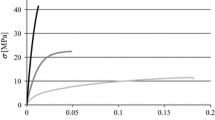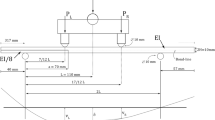Abstract
The reliability of a joint subjected to mechanical and thermal loads during processing and service constitutes a major technical problem. Joints contain flaws. The observed strength of a joint depends upon the location and size of the flaws, as well as the crack path through the joint. The aim of this investigation is to measure the fracture toughness of a crack in an adhesive joint, as well as to observe its path through the bond. Sandwich Brazilian disk specimens made of two aluminum adherends joined by a thin layer of epoxy are employed in the testing. A thin paraffin notch is located within the adhesive layer. Numerical analyses are carried out to calibrate the specimens. It is seen that asymptotic expressions for the energy release rate and phase angle of a sandwich specimen with a thin layer are inappropriate in this investigation. A wide range of mixed modes is attained with this specimen. Values of the critical energy release rate G c are obtained as a function of the phase angle ψ. A fracture criterion is compared to the results. During testing, all cracks divert from within the layer and grow toward and into the interface. Comparison of crack path direction is made to two theories.
Similar content being viewed by others
References
Akisanya, A.R. and Fleck, N.A. (1992). Brittle fracture of adhesive joints. International Journal of Fracture 58, 93–114.
Atkinson, C., Smelser, R.E. and Sanchez, J. (1982). Combined mode fracture via the cracked Brazilian disk test. International Journal of Fracture 18, 279–291.
ASTM Standard. (1999). Standard test method for plane-strain fracture toughness of metallic materials, E 399-90 (reapproved 1997) 1999 Annual Book of ASTM Standards 03.01, American Society for Testing and Materials, Philadelphia, U.S.A., 422–452.
ASTM Standard. (1999). Standard test methods for tensile properties of plastics, D 638-99, 1999 Annual Book of ASTM Standards 08.01, American Society for Testing and Materials, Philadelphia, U.S.A.
ASTM Standard. (1999). Standard test method for plane-strain fracture toughness and strain energy release rate of plastic materials, D 5045-99, 1999 Annual Book of ASTM Standards 08.03, American Society for Testing and Materials, Philadelphia, U.S.A.
Banks-Sills, L., Travitzky, N., Ashkenazi, D. and Eliasi, R. (1999). A methodology for measuring interface fracture toughness of composite materials. International Journal of Fracture 99, 143–161.
Banks-Sills, L. and Ashkenazi, D. (2000) A note on fracture criteria for interface fracture. International Journal of Fracture 103, 177–188.
Bathe, K.J. (1999). ADINA - Automatic Dynamic Incremental Nonlinear Analysis System, Version 7.3, Adina Engineering, Inc. USA.
Cao, H.C. and Evans, A.G. (1989). An experimental study of the fracture resistance of bimaterial interfaces. Mechanics of Materials 7, 295-304.
Chai, H. (1987). A note on crack trajectory in an elastic strip bounded by rigid substrates. International Journal of Fracture 32, 211–213.
Charalambides, P.G., Lund, J., Evans, A.G. and McMeeking, R.M. (1989). A test specimen for determining the fracture resistance of bimaterial interfaces. Journal of Applied Mechanics 56, 77–82.
Charalambides, M., Kinloch, A.J., Wang, Y. and Williams, J.G. (1992). On the analysis of mixed-mode failure. International Journal of Fracture 54, 269–291.
Chen, B. and Dillard, D.A. (2001). The effect of the T-stress on crack path selection in adhesively bonded joints. International Journal of Adhesion and Adhesives 21, 357–368.
Chen, B., Dillard, D.A., Dillard, J.G. and Clark, Jr., R.L. (2002). Crack path selection in adhesively bonded joints: the roles of external loads and specimen geometry. International Journal of Fracture 114, 167–190.
Chen, C.-S., Krause, R., Petit, R.G., Banks-Sills, L. and Ingraffea, A.R. (2001). Numerical assessment of T-stress computation using a p-version finite element method. International Journal of Fracture 107, 177–199.
Cotterell, B. (1966). Notes on the paths and stability of cracks. International Journal of Fracture Mechanics 2, 526–533.
Cotterell, B. (1970). On fracture path stability in the compact tension test. International Journal of Fracture Mechanics 6, 189–192.
Cotterell, B. and Rice, J.R. (1980). Slightly curved or kinked cracks. International Journal of Fracture 16, 155-169.
Dundurs, J. (1969). Edge-bonded dissimilar orthogonal elastic wedges under normal and shear loading. Journal of Applied Mechanics 36, 650–652.
Erdogan, F. and Sih, G.C. (1963). On the crack extension in plates under plane loading and transverse shear. Journal of Basic Engineering 85, 519–527.
Fleck, N.A., Hutchinson, J.W. and Suo, Z. (1991). Crack path selection in a brittle adhesive layer. International Journal of Solids and Structures 27, 1683–1703.
Hutchinson, J.W., Mear, M.E. and Rice, J.R. (1987). Crack paralleling an interface between dissimilar materials. Journal of Applied Mechanics 54, 828–832.
Hutchinson, J.W. and Suo, Z. (1991). Mixed mode cracking in layered materials. In: Hutchinson, J.W. and Wu, T.Y. (eds.) Advances in Applied Mechanics, Vol. 29, 63–191.
Kfouri, A.P. (1986). Some evaluations of the elastic T-term using Eshelby's method. International Journal of Fracture 30, 301–315.
Kinloch, A.J. and Shaw, S.J. (1981). The fracture resistance of a toughened epoxy adhesive. Journal of Adhesion 12, 59–77.
Leevers, P.S., Radon, J.C. and Culver, L.E. (1976). Fracture trajectories in a biaxially stressed plate. Journal of the Mechanics and Physics of Solids 24, 381–395.
Leevers, P.S. and Radon, J.C. (1982). Inherent stress biaxiality in various fracture specimen geometries. International Journal of Fracture 19, 311–325.
Li, F.Z., Shih, C.F. and Needleman, A. (1985). A comparison of methods for calculating energy release rates. Engineering Fracture Mechanics 21, 405–421.
Liechti, K.M. and Liang, Y.M. (1992). The interfacial fracture characteristics of bimaterial and sandwich blister specimens. International Journal of Fracture 55, 95–114.
Reimanis, I.E., Dagleish, B.J. and Evans, A.G. (1991). The fracture resistance of a model metal/ceramic interface. Acta Metallurgica 39, 3133–3141.
Schwartz, J. (2001). Determination of the critical energy release rate and crack propagation path using bimaterial sandwich specimens. M.Sc. thesis, Tel Aviv University, Israel (in Hebrew).
Selvarathinam, A.S. and Goree, J.G. (1998). T-stress based fracture model for cracks in isotropic materials. Engineering Fracture Mechanics 60, 543–561.
Sumi, Y., Nemat-Nasser, S. and Keer, L.M. (1985). On crack path stability in a finite body. Engineering Fracture Mechanics 22, 759–771.
Suo, Z. and Hutchinson, J.W. (1989). Sandwich test specimens for measuring interface crack toughness. Materials Science and Engineering A107, 135–143.
Swadener, J.G. and Liechti, K.M. (1998). Asymmetric shielding mechanisms in the mixed-mode fracture of a glass/epoxy interface. Journal of Applied Mechanics 65, 25–29.
Thouless, M.D. (1990). Fracture of a model interface under mixed-mode loading. Acta Metallurgica 38, 1135-1140.
Thurston, M.E. and Zehnder, A.T. (1993). Experimental determination of silica/copper interfacial toughness. Acta Metallurgica 41, 2985–2992.
Thurston, M.E. and Zehnder, A.T. (1996). Nickel-alumina interfacial fracture toughness: experiments and analysis of residual stress effects. International Journal of Fracture 76, 221–241.
Wang, C.H. (1997). Fracture of interfacial cracks under combined loading. Engineering Fracture Mechanics 56, 77–86.
Wang, J.S. and Suo, Z. (1990). Experimental determination of interfacial toughness curves using the Brazil-nutspecimen. Acta Metallurgica 38, 1279–1290.
Wang, J.S. (1995). Interfacial fracture toughness of a copper/alumina system and effect of the loading phase angle. Mechanics of Materials 20, 251–259.
Yau, J.F., Wang, S.S. and Corten, H.T. (1980). A mixed-mode crack analysis of isotropic solids using conservative laws of elasticity. Journal of Applied Mechanics 47, 335–341.
Author information
Authors and Affiliations
Rights and permissions
About this article
Cite this article
Banks-Sills, L., Schwartz, J. Fracture testing of Brazilian disk sandwich specimens. International Journal of Fracture 118, 191–209 (2002). https://doi.org/10.1023/A:1022922926897
Issue Date:
DOI: https://doi.org/10.1023/A:1022922926897




